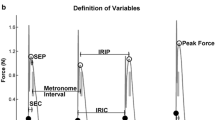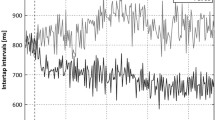Abstract
Researchers have puzzled over the phenomenon in sensorimotor timing that people tend to tap ahead of time. When synchronizing movements (e.g., finger taps) with an external sequence (e.g., a metronome), humans typically tap tens of milliseconds before event onsets, producing the elusive negative asynchrony. Here, we present 24 metronome-tapping data sets from 8 experiments with different experimental settings, showing that less negative asynchrony is associated with lower tapping variability. Further analyses reveal that this negative mean–SD correlation of asynchrony is likely to be observed for sequence types appropriate for synchronization, as indicated by the statistically negative lag 1 autocorrelation of inter-response intervals. The reported findings indicate an association between negative asynchrony and timing variability.


Similar content being viewed by others

References
Aschersleben, G. (2002). Temporal control of movements in sensorimotor synchronization. Brain and Cognition, 48(1), 66–79.
Aschersleben, G., & Prinz, W. (1995). Synchronizing actions with events: The role of sensory information. Perception and Psychophysics, 57(3), 305–317.
Cumming, G. (2014). The new statistics why and how. Psychological Science, 25(1), 7–29.
Dalla Bella, S., & Sowiński, J. (2015). Uncovering beat deafness: detecting rhythm disorders with synchronized finger tapping and perceptual timing tasks. Journal of Visualized Experiments: JoVE(97).
Dirk, V., & Wing, A. (1996). Modeling variability and dependence in timing. In Keele (Ed.), Handbook of perception and action, Vol. 2 (pp. 181–262). London: Academic Press.
Efron, B. (1979). Bootstrap methods: Another look at the Jackknife. The Annals of Statistics, 7(1), 1–26.
Field, A. P. (2001). Meta-analysis of correlation coefficients: A Monte Carlo comparison of fixed- and random-effects methods. Psychological Methods, 6(2), 161–180.
Fisher, N. I. (1993). Statistical analysis of circular data. Cambridge: Cambridge University Press.
Fujii, S., Hirashima, M., Kudo, K., Ohtsuki, T., Nakamura, Y., & Oda, S. (2011). Synchronization error of drum kit playing with a metronome at different tempi by professional drummers. Music Perception, 28(5), 491–503.
Gan, L., Huang, Y., Zhou, L., Qian, C., & Wu, X. (2015). Synchronization to a bouncing ball with a realistic motion trajectory. Scientific Reports, 5, 11974.
Gilden, D. L. (2001). Cognitive emissions of 1/f noise. Psychological Review, 108(1), 33–56.
Hasegawa, A., Okanoya, K., Hasegawa, T., & Seki, Y. (2011). Rhythmic synchronization tapping to an audio-visual metronome in budgerigars. Scientific Reports, 1, 120.
Hove, M. J., Fairhurst, M. T., Kotz, S. A., & Keller, P. E. (2013). Synchronizing with auditory and visual rhythms: An fMRI assessment of modality differences and modality appropriateness. NeuroImage, 67, 313–321.
Hove, M. J., Iversen, J. R., Zhang, A., & Repp, B. H. (2013). Synchronization with competing visual and auditory rhythms: bouncing ball meets metronome. Psychological Research Psychologische Forschung, 77(4), 388–398.
Hove, M. J., & Peter, E., & Keller (2010). Spatiotemporal relations and movement trajectories in visuomotor synchronization. Music Perception, 28(1), 15–26.
Hove, M. J., Spivey, M. J., & Krumhansl, C. L. (2010). Compatibility of motion facilitates visuomotor synchronization. Journal of Experimental Psychology. Human Perception and Performance, 36(6), 1525–1534.
Iversen, J. R., & Balasubramaniam, R. (2016). Synchronization and temporal processing. Current Opinion in Behavioral Sciences, 8, 175–180.
Iversen, J. R., Patel, A. D., Nicodemus, B., & Emmorey, K. (2015). Synchronization to auditory and visual rhythms in hearing and deaf individuals. Cognition, 134, 232–244.
Ivry, R. B. (1996). The representation of temporal information in perception and motor control. Current Opinion in Neurobiology, 6(6), 851–857.
Jacoby, N., Tishby, N., Repp, B. H., Ahissar, M., & Keller, P. E. (2015). Parameter estimation of linear sensorimotor synchronization models: Phase correction, period correction, and ensemble synchronization. Timing and Time Perception, 3(1–2), 52–87.
John, E.. Hunter, & Frank, L., & Schmidt (1990). Methods of meta-analysis: Correcting error and bias in research findings. Thousand Oaks: Sage Publications, Inc.
Krause, V., Pollok, B., & Schnitzler, A. (2010). Perception in action: The impact of sensory information on sensorimotor synchronization in musicians and non-musicians. Acta Psychologica, 133(1), 28–37.
Lee, D. N., & Young, D. S. (1985). Visual Timing of Interceptive Action. In Brain Mechanisms and Spatial Vision (pp. 1–30). Dordrecht: Springer.
Mates, J., Radil, T., & Pöppel, E. (1992). Cooperative tapping: time control under different feedback conditions. Perception and Psychophysics, 52(6), 691–704.
Mauk, M. D., & Buonomano, D. V. (2004). The neural basis of temporal processing. Annual Review of Neuroscience, 27, 307–340.
Nijhawan, R. (2008). Visual prediction: Psychophysics and neurophysiology of compensation for time delays. Behavioral and Brain Sciences, 31(02), 179–198.
Open Science Collaboration. (2015). Estimating the reproducibility of psychological science. Science, 349(6251), aac4716.
Patel, A. D. (2014). The evolutionary biology of musical rhythm: Was Darwin wrong? PLoS Biology, 12(3), e1001821.
Patel, A. D., Iversen, J. R., Bregman, M. R., & Schulz, I. (2009). Experimental evidence for synchronization to a musical beat in a nonhuman animal. Current Biology, 19(10), 827–830.
Patel, A. D., Iversen, J. R., Chen, Y., & Repp, B. (2005). The influence of metricality and modality on synchronization with a beat. Experimental Brain Research, 163(2), 226–238.
Philipp, B. (2009). CircStat: A MATLAB toolbox for circular statistics. Journal of Statistical Software, 31(10), 1–21.
Repp, B. (2005). Sensorimotor synchronization: a review of the tapping literature. Psychonomic Bulletin and Review, 12(6), 969–992.
Repp, B., & Su, Y.-H. (2013). Sensorimotor synchronization: A review of recent research (2006–2012). Psychonomic Bulletin and Review, 20(3), 403–452.
Repp, B. H. (2010). Sensorimotor synchronization and perception of timing: Effects of music training and task experience. Human Movement Science, 29(2), 200–213.
Stenneken, P., Prinz, W., Cole, J., Paillard, J., & Aschersleben, G. (2006). The effect of sensory feedback on the timing of movements: Evidence from deafferented patients. Brain Research, 1084(1), 123–131.
Wagenmakers, E.-J., Farrell, S., & Ratcliff, R. (2004). Estimation and interpretation of 1/fα noise in human cognition. Psychonomic Bulletin and Review, 11(4), 579–615.
Wolpert, D. M., & Flanagan, J. R. (2001). Motor prediction. Current Biology, 11(18), R729–R732.
Wu, X., Westanmo, A., Zhou, L., & Pan, J. (2013). Serial binary interval ratios improve rhythm reproduction. Frontiers in Psychology, 4, 512.
Acknowledgements
We thank Liying Zhan, Xiaolin Mei, and Jiehui Qian for their help in preparing the revision, and Jacob Dufault for his help in improving the language.
Funding
This study was funded by National Natural Science Foundation of China (Grant number 31371129), Research Project of Sun Yat-Sen University (Grant number 26000-31620003), and the Philosophical and Social Science Project of Guangdong Province (Grant number GD12YXL02).
Author information
Authors and Affiliations
Contributions
WX conceived the research; YJK, OYFY, HL, and WX designed the research; YJK, HYY, GLY, ZL, CHZ, WMY, and HMX collected experimental data; YJK analyzed experimental data; ZS, YB, and PJH were involved in the discussion of data; YJK, OYFY, HL, and WX wrote the manuscript. All authors commented on and edited the manuscript.
Corresponding authors
Ethics declarations
Conflict of interest
The authors declare that they have no conflict of interest.
Ethical approval
All procedures performed in studies involving human participants were in accordance with the ethical standards of the institutional and/or national research committee and with the 1964 Helsinki declaration and its later amendments or comparable ethical standards.
Informed consent
Informed consent was obtained from all individual participants included in the study.
Electronic supplementary material
Below is the link to the electronic supplementary material.
Rights and permissions
About this article
Cite this article
Yang, J., Ouyang, F., Holm, L. et al. Tapping ahead of time: its association with timing variability. Psychological Research 84, 343–351 (2020). https://doi.org/10.1007/s00426-018-1043-2
Received:
Accepted:
Published:
Issue Date:
DOI: https://doi.org/10.1007/s00426-018-1043-2



